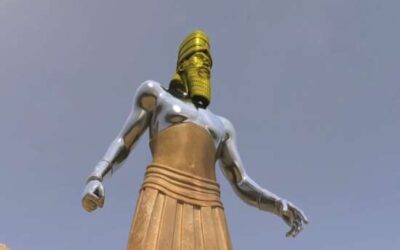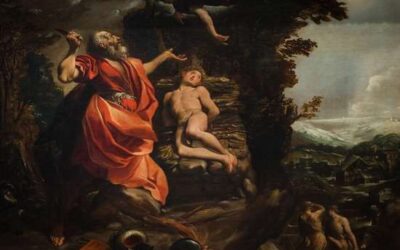Prophets seem like something from novels or movies.
The seven churches were churches that received messages from Jesus Christ through the apostle John while he was exiled on the island of Patmos. These letters are in chapters 2 and 3 of Revelation.
But beyond being literal churches in the cities of the Roman Empire, each of the churches also represents a time period of the church in history, all the way to the end times before Jesus returns.
Here, we’ll give you an overview of each church, what Jesus told the people of that church, and what period the church represents. We’ll look at:
- What the seven churches of Revelation are
- The church of Ephesus
- The church of Smyrna
- The church of Pergamum
- The church of Thyatira
- The church of Sardis
- The church of Philadelphia
- The church of Laodicea
Let’s start with what the seven churches are all about.
What the seven churches of Revelation are
The seven churches in Revelation 2 and 3 are Ephesus, Smyrna, Pergamum, Thyatira, Sardis, Philadelphia, and Laodicea. They were all in the Roman province of Asia (modern-day Turkey).
But these were just a few of the churches in the New Testament times. Christians worshiped in many other towns and cities around the Mediterranean, such as Phillipi, Antioch, Colossae, and Rome.
Why, then, did Jesus send messages to only seven churches?
Jesus must’ve selected these churches because He knew their specific characteristics would symbolize the Christian Church during different time periods in history.
See, the book of Revelation is filled with symbols.
The seven churches are just the first of many sets of seven described in Revelation: seven Spirits, seven candlesticks, seven stars, seven lamps, seven seals, seven horns, seven eyes, seven angels, seven thunders, and seven trumpets—each one symbolic.
For example, the seven stars represent angels, and the seven lampstands represent the churches (Revelation 1:20).
And in the Bible, the number seven itself is a symbol of perfection.1
Thus, each church in Revelation 2 and 3 corresponds chronologically to a period in time, and each problem the church faced represents the problems of God’s people during that corresponding period in history.
Scholars who wrote the Seventh-day Adventist Bible Commentary point out:
“A study of history reveals that these messages are, indeed, applicable in a special way to seven periods that cover the entire history of the church.”2
But even so, these messages also apply to Christians during the various stages of their own walk with God. The messages are relevant to us, helping us be aware of things that will happen in our time (Revelation 1:1).
Let’s dig deeper into each one.
The church of Ephesus

Photo by Osama Saeed on Unsplash
The first of the seven churches is Ephesus, which means “desirable” or “lovely”—an apt description of its spiritual condition. The message to this church is in Revelation 2:1–7.
Ephesus was a powerful city, situated on the western coast of Asia Minor, and it had a Christian congregation founded by the apostle Paul (Acts 19:1–8).
These Christians worked hard to spread the good news of Jesus to those around them. Jesus congratulates them, saying,
“I know your works, your labor, your patience, and that you cannot bear those who are evil…. [A]nd you have persevered and have patience, and have labored for My name’s sake and have not become weary” (Revelation 2:2–3, NKJV).
The church of Ephesus was apparently on fire for God.
Yet it had a problem: the people had become focused on all the beneficial things they were doing and had forgotten their first love for Jesus (Revelation 2:4).
Jesus proposed a solution to help get them back on track. He told them to do three things:
- Remember their love and zeal for God and others
- Repent
- Do what they did at first
In His message to them, Jesus speaks of Himself as “He…who walks in the midst of the seven golden lampstands” (Revelation 2:1, NKJV).
This title has special relevance to Ephesus.
The lampstands alluded back to the sanctuary in the Old Testament, where the high priest would keep the lamps continually burning (Leviticus 24:1–4). Similarly, Jesus is among His church (Revelation 1:20), helping to make sure it doesn’t lose its fire and zeal.
The Ephesian church represented the early Christian age—from the first century to about A.D. 100. These Christians were definitely full of zeal. The book of Acts records many stories that illustrate their passion for Jesus.
For example, Acts 3 records Peter and John, Jesus’ disciples, healing people by God’s power.
And when both Stephen and Paul were brought to trial for their beliefs, neither wavered, preferring stoning rather than giving up their faith (Acts 7:58–60; 14:19).
The gospel spread rapidly, helped by the travels of the apostles. Paul made four separate journeys—missionary trips—around the Mediterranean, preaching and planting churches.
But even in this period, God’s people were at risk of allowing their fervor to die. Only by keeping their focus on Jesus and continuing to walk by faith would they hold onto that deep-seated fervor for God.
Especially when trials and persecution would become stronger.
The church of Smyrna
 The message to Smyrna, the persecuted church, is in Revelation 2:8–11. It was one of the two churches that Jesus did not correct.
The message to Smyrna, the persecuted church, is in Revelation 2:8–11. It was one of the two churches that Jesus did not correct.
Instead, He commended the church for remaining strong through persecution, saying that despite their poverty, they were actually rich. This reflects Proverbs 8:10–11, which highlights the wealth that comes from knowing Jesus:
“Receive My [Jesus’] instruction, and not silver, and knowledge rather than choice gold; for wisdom is better than rubies, and all the things one may desire cannot be compared with her” (NKJV).
The name Smyrna means “sweet fragrance” or “myrrh.” Myrrh is an herb that lets out a “fragrant odor” when crushed.3
Similarly, when God’s people at this time experienced crushing persecution, their lives revealed the fragrance and love of Christ (Ephesians 5:2).
And in the midst of their persecution, Jesus had encouragement for Smyrna. He came to them as the “First and the Last, who was dead, and came to life” (Revelation 2:8, NKJV). He reminded them that He was in control of death and life.
He added,
“Do not fear any of those things which you are about to suffer. Indeed, the devil is about to throw some of you into prison, that you may be tested, and you will have tribulation ten days. Be faithful until death, and I will give you the crown of life” (Revelation 2:10, NKJV).
Ten days?
That doesn’t seem very long, but in Bible prophecy, a day stands for one year (Ezekiel 4:5–6). So, Jesus is actually telling them they’ll be persecuted for ten years.
This really happened in history. The Smyrna church prophetically stands for the post-apostolic church that existed from about A.D. 100–313. During this time, the Roman Empire persecuted Christians, imprisoning and murdering scores of them.4
The worst of it came during the tenure of the emperor Diocletian, who reigned from A.D. 303–313—a span of 10 years.5
But after persecution, the Christian church faced even greater danger. Find out about that next.
The church of Pergamum

Photo by Ricardo Cruz on Unsplash
The third church John writes to—Pergamum, or Pergamos—sat on top of a hill near two tributaries of the Caicus River. This could be why the city’s name meant “high” or “elevation.”
John addressed this church in Revelation 2:12–17. Its members had remained faithful to God, even when one of them was martyred in the city.
He did have one problem to correct them about, though: compromise.
In growing their church, the Pergamum Christians had incorporated beliefs of the pagan religions around them:
“But I have a few things against you, because you have there those who hold the doctrine of Balaam, who taught Balak to put a stumbling block before the children of Israel, to eat things sacrificed to idols, and to commit sexual immorality” (Revelation 2:14, NKJV).
Pergamum was a city saturated in idolatry. Temples to Diana, Zeus, and other gods crowded the streets.6 By incorporating pagan practices, the Christians were diluting the pure teachings of Jesus.
In His message to them, Jesus calls Himself “He who has the sharp two-edged sword” (Revelation 2:12, NKJV). The two-edged sword represents the Word of God, which is “living and powerful, and sharper than any two-edged sword” and is “a discerner of the thoughts and intents of the heart” (Hebrews 4:12, NKJV).
He asks the Pergamum Christians to “repent, or else I will come to you quickly and will fight against them with the sword of My mouth” (Revelation 2:16, NKJV).
God’s Word would be the standard of judgment for those who deliberately chose to disobey Him (Revelation 19:15, 21).
The Christian church as a whole went through a time of compromise too. It began after the time of persecution, lasting from about A.D. 313–538.
In A.D. 313, the emperor Constantine legalized Christianity and made it the official religion of Rome.7
You might think this was a good thing.
But it came at a price. To gain converts, the Church began to accept pagan practices, while the pagans joined the church to gain favors. It was a time of compromise—dilution—that led to spiritual decline and a weaker church.
The church of Thyatira

Photo from Unsplash
Thyatira was a city on the banks of the Lycus River that was known for its dyeing and indigo trade. The name Thyatira means “perfume of labor.”
Revelation 2:18–29 describes the situation of the church. They had many good attributes, like love, faith, patience, and wonderful deeds (Revelation 2:19).
But they also had some serious things they needed to work on. John wrote,
“You allow that woman Jezebel, who calls herself a prophetess, to teach and seduce My servants to commit sexual immorality and eat things sacrificed to idols. And I gave her time to repent of her sexual immorality, and she did not repent” (Revelation 2:20–21, NKJV).
This passage is clearly referring back to Jezebel, an evil queen in the Old Testament who promoted idol worship and caused God’s people to turn away from Him (1 Kings 16:29–33).
Here, she represents a corrupt church.
The symbol of a woman has been used to represent God’s people throughout the Bible (Ephesians 5:23; Revelation 19:17).
An immoral woman represents God’s people abandoning Jesus’ teachings. We find this in the book of Hosea, where God compared Hosea’s marriage to a prostitute with His relationship to His people. Prostitution illustrated the unfaithfulness of God’s people to Him (Ezekiel 23:7; Hosea 1:2; 4:10).
In His letter, Jesus says He is the “Son of God, who has eyes like a flame of fire” (Revelation 2:18, NKJV). With this title, He presents Himself as the one who is able to read hearts and execute judgment (Psalm 139:23–24; Revelation 2:23).
The church of Thyatira represents the Church during the Middle Ages. Propelled by state power, the Church held to unbiblical traditions and persecuted groups that disagreed.8
But not all within Thyatira accepted those traditions.
Jesus encouraged “the rest in Thyatira, as many as do not have this doctrine” by telling them to “hold fast what you have till I come” (Revelation 2:24–25, NKJV).
Even during this time of false teaching, some Christians remained faithful and helped turn people back to God’s Word, particularly during the Reformation.
The church of Sardis
In Revelation 3:1–6, we read of Sardis, the dead church. In name, they’re alive, but inside they’re dead.
Sardis, sitting at the base of Mount Tmolus near the river Pactolus, was an old and well-defended city. Externally, the church there appeared to be prosperous, but inwardly, the people were indifferent. The power of God was gone.
Jesus advises them to regain their close connection with God with three instructions: be watchful, hold fast to Jesus, and repent.
He tells them,
“Be watchful, and strengthen the things which remain, that are ready to die, for I have not found your works perfect before God. Remember therefore how you have received and heard; hold fast and repent. Therefore if you will not watch, I will come upon you as a thief, and you will not know what hour I come upon you” (Revelation 3:2–3, NKJV).
Jesus knew that a connection with Him was vital. He is the one who “has the seven Spirits of God and the seven stars” and could revive the spiritually dead church (Revelation 3:1, NKJV). It’s similar to the way the Holy Spirit brought life to the dry bones in Ezekiel’s vision (Ezekiel 37).
Sardis represents the time from the end of the Reformation to right before the Second Great Awakening.9
As new generations came up after the time of the Reformers, they began to stagnate in their faith. Seventh-day Adventist theologian George Burnside describes it this way:
“The reformers were men of God, but their followers, thinking that all was won, settled down to organized religion. Many became state religions supported by government funds.”10
During these years, Christians lapsed into tradition and an indifferent shell of worship as they had before.
But in the midst of this spiritual deadness, some remained true to the Bible and began revivals in the church.
The church of Philadelphia

Photo by Womanizer Toys on Unsplash
Philadelphia, which means “brotherly love,” was located along the Imperial Post Road—an important trade route—and held the only other church to receive no correction from Jesus. Revelation 3:7–13 contains the message that describes this faithful congregation.
Jesus praises them:
“For you have a little strength, have kept My word, and have not denied My name” (Revelation 3:8, NKJV).
Jesus’ name in this letter is “He who is holy, He who is true,” mirroring the Philadelphians’ earnest, unwavering faith (Revelation 3:7, NKJV). It also reveals Jesus’ role as judge (Revelation 6:10).
Despite the vast array of idols and gods in Philadelphia, the Christians there didn’t allow themselves to be distracted.
Because they were so faithful, Jesus makes this promise to them:
“Because you have kept My command to persevere, I also will keep you from the hour of trial which shall come upon the whole world, to test those who dwell on the earth” (Revelation 3:10, NKJV).
He encourages them to hold fast to Him, and those who did would have the name of God written on them.
The church of Philadelphia symbolizes the time of spiritual awakening in the late 1700s to mid-1800s. This was a time when powerful preachers and evangelists revived their congregations, studying the Bible in earnest.
The Millerite Movement, which preached the imminence of the Second Coming, took place during this time period. And the Seventh-day Adventist Church was born soon after.
The church of Laodicea
The last of the seven churches is Laodicea, discussed in Revelation 3:14–22.
Just as the meaning of Laodicea is “judging of the people,” Jesus evaluates the Laodicean church and immediately points out their problem. They weren’t dead or overly zealous in their Christian faith—just lukewarm:
“I know your works, that you are neither cold nor hot. I could wish you were cold or hot. So then, because you are lukewarm, and neither cold nor hot, I will vomit you out of My mouth…. [Y]ou say, ‘I am rich, have become wealthy, and have need of nothing’—and do not know that you are wretched, miserable, poor, blind, and naked” (Revelation 3:15–17, NKJV).
Chilling words.
The Laodicean church would have understood this metaphor of lukewarm spirituality. The city of Laodicea, located at a junction of multiple important trade routes, had a water supply full of sediment. To get clean water, they piped it from hot springs six miles away. By the time the water reached the city, it was lukewarm.11
Likewise, the Laodicean church was no longer full of the warmth of the love of God. And it didn’t realize its true condition.
To remedy this, Jesus said,
“I counsel you to buy from Me gold refined in the fire, that you may be rich; and white garments, that you may be clothed, that the shame of your nakedness may not be revealed; and anoint your eyes with eye salve, that you may see” (Revelation 3:18, NKJV).
These items were symbolic, as mentioned by the Seventh-day Adventist Bible Commentary:12
- The gold refined in the fire is Jesus’ pure truth, faith, and love (1 Peter 1:7).
- The white garments are the righteousness of God (Revelation 19:8).
- The anointing of the eyes with eye salve is the giving of spiritual discernment by the Holy Spirit (1 John 2:27).
Jesus’ title in this letter is fitting. He is “the Faithful and True Witness” (Revelation 3:14, NKJV). He faithfully told them the truth about their condition because they were caught in self-deception.
And He did so because He cared for them:
“As many as I love, I rebuke and chasten” (Revelation 3:19, NKJV).
This church characterizes the church of the end times, shortly before Jesus returns. God’s people at this time in history are living during the time of the Investigative Judgment right before the Second Coming.
Yet they’re neither religiously on fire nor spiritually dead. They are somewhere in between, thinking that they’re alright when they’re really not.
Because we’re living in the end times before Jesus’ return, we could easily fall into this lukewarmness.
But Jesus doesn’t give up on us.
He stands at the door of our hearts. He won’t force Himself in, but if we choose to let Him, He will gladly enter and make us into overcomers (Revelation 3:20–21).
The lessons of the seven churches still apply to us today
The fact that God gave messages to seven churches in the book of Revelation is significant. It is God’s perfect number, repeated throughout the Bible.
It reflects His perfect plan for history and humanity.
Even before the time periods took place, God had it all figured out—and provided the instructions, counsel, and warnings that His people would need at various times.
Though each church symbolizes a specific period of time, there are elements of each church in any given time period.
And the corrections and praises apply to our own lives and churches just as much as they did in ages past.
These messages challenge us to evaluate our own lives and allow the Holy Spirit to point out areas in which we’re struggling. At the same time, they remind us of how much Jesus cares about us and wants us to grow in Him and be prepared for His coming.
- White, Ellen, Acts of the Apostles, pp. 585–586. [↵]
- Seventh-day Adventist Bible Commentary, vol. 7, entry for Revelation 1:11. [↵]
- Bunch, Taylor, The Seven Epistles of Christ, pp. 130–131. [↵]
- Arnold, Jack, “Church History: Persecution by the State: A.D. 60-313, Early Church History, Part 9,” Third Millennium Magazine. [↵]
- “The Great Persecution,” If Gathering.com, IF Gathering, Accessed 9 February 2023. [↵]
- “Pergamos,” The Cyclopedia of Biblical, Theological, and Ecclesiastical Literature. [↵]
- Denova, Rebecca, “Constantine’s Conversion to Christianity,” World History Encyclopedia. [↵]
- Mark, Joshua, “Six Great Heresies of the Middle Ages,” World History Encyclopedia. [↵]
- “Sardis—The Dead Church,” Lineage Journey. [↵]
- Burnside, George, Revelation’s Wonders Unfolded, p. 53. [↵]
- Keeth, Crickett, “Laodicea—The Lukewarm Church,” Bible.org. [↵]
- Seventh-day Adventist Bible Commentary, vol. 7, p. 965. [↵]
More Answers
Judges of Israel and lessons we can learn from them
Times of crisis call for men and women of action. The Israelites, newly settled in the Promised Land, found themselves in those times. As enemy nations attacked and oppressed the tribes, they cried out to God for help. He, in turn, sent them men and women of action—known as judges.
What Is the Statue in Nebuchadnezzar’s Dream?
Ever had a dream you couldn’t remember? You know it was disturbing, but the details escape you. Ugh, the frustration!
What Are the Three Angels’ Messages in Revelation 14?
Revelation 14 in the Bible depicts three angels flying swiftly to the earth with important messages for the world right before Christ returns.
All About the 2300-Day Prophecy and the Investigative Judgment
Daniel 8:14 introduces us to the longest prophetic timeline in the Bible—the 2300-day prophecy. So what does it mean? When does it start and end, and why’s it so important?
What Is the 70-Week Prophecy in Daniel 9
Could a prophecy accurately predict an event over 500 years before it was supposed to happen?
The Creation of the World: What the Bible Really Says
When we think about the biblical Creation story, we think of just that: the world being created by the Creator. And while God’s creation of the world is marvelous and miraculous in its own right, it’s about far more than the sudden appearance of plants, animals, and humans.
Individual or Group Bible Study—Which Is Better?
They’re both great, of course! But depending on where you’re at and what your goals are, it’s worth looking into the different benefits of each.
Who Were the Israelites in the Bible?
The Israelites in the Bible, also known as the children of Israel or ancient Israel, were a nation God called to represent Him to the world. They come from the line of Abraham, whom God first made a covenant with, promising to make his descendants into a great nation (Genesis 12:1-3).
Bible Translations
Bible Translations—Which English Language Version is “Best”?The most accurate Bible possible would be one that’s printed in its original languages—Hebrew and Greek. But since most of us are not Hebrew or Greek scholars, the next best option is to find a Bible...
What’s the History of the Bible? A Complete Overview
The Bible is the number one bestseller in the world of all time.1 It’s translated into thousands of languages, read by people of all ages and backgrounds.
false vs true prophets
Have you ever wondered how people in Bible times were able to tell if their prophets were actually from God?
What Are the Beatitudes (And What Do They Mean)?
The Beatitudes, found at the beginning of Jesus’ Sermon on the Mount in the Gospel of Matthew, are Jesus’ kingdom manifesto. They describe the way His kingdom works and what it means to be one of His followers.
What Is the Fruit of the Holy Spirit in the Bible?
When we cultivate our relationship with Jesus, the Holy Spirit gives us traits that help us in our day-to-day activities and interactions. These are the fruit of the Spirit.
Healing in the Bible
Have you ever felt like healing seemed so far away? Like it wouldn’t be possible for you? What you most want is a glimmer of hope or a bit of encouragement.
Faith and Works—Do Both Matter in the Christian Life?
In so many religions all throughout time, individuals work toward enlightenment, salvation, or the favor of a deity. People are taught subtly—or not so subtly—that if you only do enough good deeds, you’ll be worthy/ascended/redeemed/approved, etc.
Does the Bible Teach Predestination?
Do your choices, actions, and habits really matter to your eternal destiny? Or is the path you choose in life predetermined, and your life is just following a script that’s been laid out for you?
The Armor of God as Described in Ephesians
In Ephesians 6, the Apostle Paul was helping people understand what it means to defend themselves within a spiritual war (Ephesians 6:10-18).
The Story of Moses in the Bible: What His Life Teaches Us
A baby on death row, an outcast prince, a humble shepherd, and an unlikely deliverer. All these titles describe the individual that led Israel out of slavery in Egypt to the borders of the Promised Land.
The 42 Kings (and 1 Queen) of Israel and Judah in the Bible
Ever wondered who all the kings of Israel and Judah in the Bible were? Meet all 42 (plus 1 queen) and learn profound, unexpected lessons from their stories
What We Can Learn from the Life of Joshua
Joshua was an iconic leader in the Old Testament of the Bible. As a successor to Moses, he was both a humble servant of God and a strong warrior. God called Him to lead the nation of Israel to take possession of Canaan, the Promised Land—a task he took on with faith and courage.
Why is Abraham Important in the Bible?
Abraham is known for being the first patriarch of the Hebrew people.
King David: How Was He a Man After God’s Own Heart?
War, bloodshed, murder, adultery—all of these crimes overshadowed the life of a biblical Old Testament man named David. Yet he was called a man after God’s own heart, not to mention one of Israel’s greatest heroes and kings.
Life Lessons from Joseph in the Bible
Joseph is one of the more well-known people from the Bible’s Old Testament. He showed remarkable strength, faith, and patience—even while facing great difficulty and injustice. All because he let God lead.
Is the Old Testament Important for Christians Today?
Yes, the Old Testament is important because it kicks off the story that is continued by the New Testament. Without it, we wouldn’t have the vital background to Jesus’ first coming and the other accounts of the New Testament.
What Does the Bible Say About the End Times?
First of all, when we say “end times,” this refers to the period of time that precedes the second coming of Jesus—and the end of this sinful world before it’s recreated into the new earth. And several passages of Scripture provide us with clues and guidelines to help us recognize when these times are near, what kinds of things we can expect, and what it might mean for our daily lives and priorities.
Why Do Some Bibles Have More Books Than Others?
Christians consider the Bible as their sacred writings. But within Christianity, different denominations use Bibles with different numbers of books.
Didn’t find your answer? Ask us!
We understand your concern of having questions but not knowing who to ask—we’ve felt it ourselves. When you’re ready to learn more about Adventists, send us a question! We know a thing or two about Adventists.




























